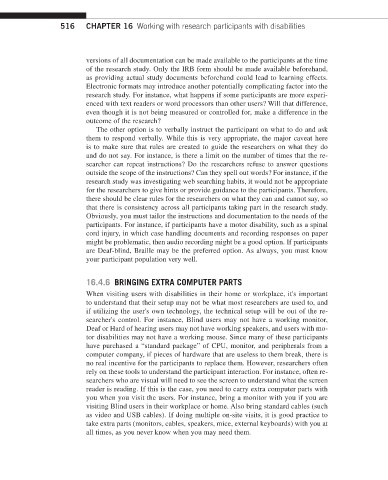Page 523 -
P. 523
516 CHAPTER 16 Working with research participants with disabilities
versions of all documentation can be made available to the participants at the time
of the research study. Only the IRB form should be made available beforehand,
as providing actual study documents beforehand could lead to learning effects.
Electronic formats may introduce another potentially complicating factor into the
research study. For instance, what happens if some participants are more experi-
enced with text readers or word processors than other users? Will that difference,
even though it is not being measured or controlled for, make a difference in the
outcome of the research?
The other option is to verbally instruct the participant on what to do and ask
them to respond verbally. While this is very appropriate, the major caveat here
is to make sure that rules are created to guide the researchers on what they do
and do not say. For instance, is there a limit on the number of times that the re-
searcher can repeat instructions? Do the researchers refuse to answer questions
outside the scope of the instructions? Can they spell out words? For instance, if the
research study was investigating web searching habits, it would not be appropriate
for the researchers to give hints or provide guidance to the participants. Therefore,
there should be clear rules for the researchers on what they can and cannot say, so
that there is consistency across all participants taking part in the research study.
Obviously, you must tailor the instructions and documentation to the needs of the
participants. For instance, if participants have a motor disability, such as a spinal
cord injury, in which case handling documents and recording responses on paper
might be problematic, then audio recording might be a good option. If participants
are Deaf-blind, Braille may be the preferred option. As always, you must know
your participant population very well.
16.4.6 BRINGING EXTRA COMPUTER PARTS
When visiting users with disabilities in their home or workplace, it's important
to understand that their setup may not be what most researchers are used to, and
if utilizing the user's own technology, the technical setup will be out of the re-
searcher's control. For instance, Blind users may not have a working monitor,
Deaf or Hard of hearing users may not have working speakers, and users with mo-
tor disabilities may not have a working mouse. Since many of these participants
have purchased a “standard package” of CPU, monitor, and peripherals from a
computer company, if pieces of hardware that are useless to them break, there is
no real incentive for the participants to replace them. However, researchers often
rely on these tools to understand the participant interaction. For instance, often re-
searchers who are visual will need to see the screen to understand what the screen
reader is reading. If this is the case, you need to carry extra computer parts with
you when you visit the users. For instance, bring a monitor with you if you are
visiting Blind users in their workplace or home. Also bring standard cables (such
as video and USB cables). If doing multiple on-site visits, it is good practice to
take extra parts (monitors, cables, speakers, mice, external keyboards) with you at
all times, as you never know when you may need them.

